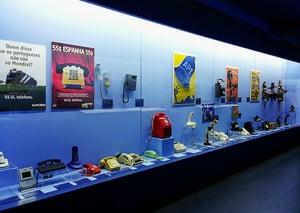The Portuguese Communications Foundation (FPC) and the National Communications Authority (ANACOM), opened the exhibition The submarine cable in a sea of connectivity, on the occasion of the World Telecommunications and Information Society Day celebrations.
This exhibition, with the High Sponsorship of His Excellency the President of the Republic, highlights the important role that Portugal has played in the world network of submarine cables, since 1870, the year when the first submarine telegraph cable connecting Portugal to the United Kingdom came into service.. Portugal’s geostrategic location and its capacity for innovation were essential elements for the country to be a mooring point for international systems, promoting and facilitating traffic between continents and contributing to unite communities.
Over several decades Portugal, attracted several submarine cable companies, English, North American, German and Italian. Today, there are more than half a million kilometers of submarine optical cables in the 5 oceans, with Portugal having 10 moorings for international submarine optical systems. All this enormous growth in the installation of submarine cables and their capabilities has an explanation: the Internet. The Internet, as we know it today, requires high speeds and capacities only possible with optical transmission, with submarine cable being the major highway for communications. That is where 99% of Internet traffic passes between different continents.
Today, there are more than half a million kilometers of submarine optical cables in the 5 oceans and Portugal has 10 moorings for international submarine optical systems, one of the main cable mooring points and is still the only country in the world with direct connections with all continents, with the exception of Antarctica.
All this huge growth in the installation of submarine cables and their capabilities has an explanation: the Internet. The Internet, as we know it today, requires high speeds and capacities only possible with optical transmission, with submarine cable being the major highway for communications. That is where 99% of Internet traffic passes between different continents.
It is in this context, from the past to the present, that this exhibition aims to present historical aspects related to this technology, its current developments and also to envision the future of this important transmission system.
Portuguese Communications Foundation
The Communications Museum, opened in 1997 at Rua do Instituto Industrial, 16, in Lisbon, is a pedagogical space of scientific and technological nature, where, in a playful and interactive way, you can have access to information about the past of communications and also about the technologies of the future. The Communications Museum belongs to the Portuguese Communications Foundation – FPC, and is responsible for the museological collection of its founders ( ANACOM, CTT and Portugal Telecom ) and for its dissemination.
Located in the riverside area of Lisbon, The Portuguese Communications Foundations (FPC) was created in 1997 by the founding members ANACOM, CTT and MEO.
The FPC is the guardian of Portugal’s communication heritage and its chief purpose is to conserve and divulge it. It also aims to assert itself as a nationally and internationally recognised cultural and scientific institution that plays an active role in promoting citizenship, literacy, learning and social inclusion.
The existing heritage includes a valuable collection of pieces ranging from the 16th century to the present day.
This heritage is grouped into the Postal, Telecommunications and Art and Philately collections. It can also be consulted in the Historical Archive, Iconography Archive and the Library, and online in the Digital Catalogues.
The Museum of Communications is an active and visible part of the achievement of the Foundation’s purpose. It holds exhibitions on the science and techniques linked to the sector, allowing visitors to learn about its history and to experience the future of technologies, highlighting the permanent exhibitions Overcoming Distance – Five Centuries of Communications in Portugal, Mail Coach and the House of the Future in the Cloud – Living in a Smart City, as well as exhibitions of contemporary art.
The Foundation is therefore a place in which the past, present and future of communications are intertwined. It is a platform for innovation and experimentation in new technologies and their impact on the way people organise and live their daily lives.





